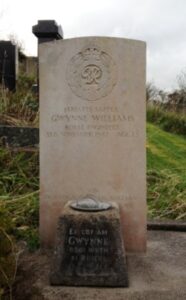Dinas Cross is a small village sat in a picturesque location between Fishguard and Newport in the Pembrokeshire Coast National Park. The War Memorial to the men of the Parish that gave their lives during both World Wars takes the form of marble plaques fixed onto a masonry wall and is situated alongside the main road through the village, in front of the local school. Many thanks are due to Rex Harries, of Dinas, for sending in more details of the WW2 casualties.
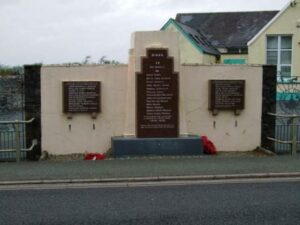
The Great War, 1914-1918
Price Gibby, Corporal, 40724, Cheshire Regiment. Price was born in 1897, the son of David and Magdalen Gibby, of Glanymor, Dinas. The family later took up the running of the Royal Oak, Newport. Price worked in Llandeilo prior to the war, and enlisted at Ammanford into the 15th Service Battalion, Cheshire Regiment, a Bantam Battalion which formed part of 105 Brigade, 35th Division. The Division first fought at the opening stage of the Somme Battle, then during the Battle of Passchendaele and during the German Offensive in Flanders, which was launched on 9 April 1918, splitting the British forces on the Lys. Price was killed in action on 4 July 1918, aged 21. He is buried at Westoutre British Cemetery, Belgium in Grave K. 1.
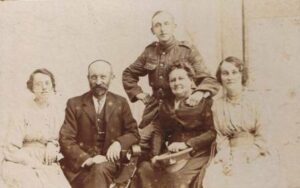
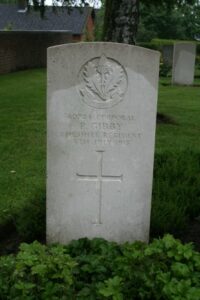
David James Harries, First Mate, Mercantile Marine. David was born in 1878, the son of John and Ann Harries, of Soar Hill, Dinas Cross, and was the brother of Elizabeth Harries. He served with the Mercantile Marine as First Mate, aboard the SS Don Arturo, a London registered ship, belonging to the Buenos Aires and Pacific Railway Company Limited. On 25 June 1917 Don Arturo was on route from Algiers and Oran for the Tees when she was torpedoed by German submarine UC-62 and sunk some ninety miles wsw of the Scilly Isles. David was 39 years old when he died that day, and is commemorated on the Tower Hill Memorial, London.
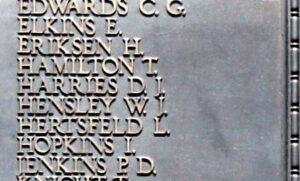
Owen Jenkins, Mate, Mercantile Marine. Owen was born around 1868, the son of John and Martha Jenkins, of Veiderfawr, Dinas. He was the husband of Mary Ann Jenkins, of Bay View Terrace, Dinas Cross. Owen served in the Mercantile Marine as Mate, aboard the SS Whitgift, a London registered vessel. Whitgift was a 4,397 ton Merchant ship. On 20 April 1916, when on route from Almeria for the Tyne, she was torpedoed by German submarine U-67 when off the Ushant. She went down with the loss of 32 men, including her Master. Owen was one of the men to go down with the ship. He was 46 years old, and is commemorated on the Tower Hill Memorial, London.
John Rees Jones, Private, 117563, Machine Gun Corps. John was the son of William and Anna Jones, of Werndew, Dinas Cross. He resided at Newport prior to the war, and enlisted at Carmarthen into the Welsh Regiment. Prior to the Battle of the Somme, Battalion machine gunners were formed into a Machine Gun Corps. John was transferred into the 38th Battalion, Machine Gun Corps, which were part of the 38th (Welsh) Division, and he fought with the Division at Mametz Wood, before moving to Flanders and fighting at Third Ypres. The Division had returned to the Somme in mid 1918, where they fought at the Battle of Albert, and this is when John was wounded. He died of wounds at an Advanced Dressing Station on 1 September, 1918, aged 24, and is buried in Contalmaison Chateau Cemetery, France. The memorial gives the name of John Henry Jones.
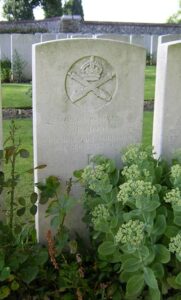
Thomas Vaughan Llewellyn, Private, 442718, Canadian Infantry. Thomas was born at Spring Hill, Dinas Cross on 15 May 1882, the son of John and Maria Llewellyn. He became a miner, and emigrated to Canada prior to the outbreak of the Great War. On 17 August 1915, Tom enlisted at Vernon Camp into the Canadian Expeditionary Force. Tom then embarked for Britain as one of a batch of reinforcements for the 2nd Battalion (Eastern Ontario), CEF, attached to 1st Canadian Brigade, 1st Canadian Division. The Battalion had arrived at Plymouth from Canada on 14 August 1914, aboard the SS Cassandra. After months of training, the Battalion landed with the 1st Canadian Division in France during February 1915, and took the line at Ypres, where they were among the first troops to have ever been attacked with poison gas. After a desperate defence, which saw the Canadians valiantly hold their line, they remained at Ypres over the coming months, and saw plenty of action during the Second Battle of Ypres. The Division moved to the Somme in July 1916, which is probably where Tom joined his Battalion, and took up positions near Flers. On 9 September 1916 the 2nd Battalion moved back into the front line, relieving the 4th Battalion. The battalion moved into positions, and launched an attack on the German lines at Flers at around 4.48 p.m. By 5.27 p.m. the Canadians had attained their objectives, although a large number of men had been cut down by German machine-gun fire. The dead were buried the following morning, before the 2nd Battalion was relieved and returned to billets at Albert. Among the dead was Tom. He was 38 years old, and is now buried in Adanac Military Cemetery, Miraumont, France.
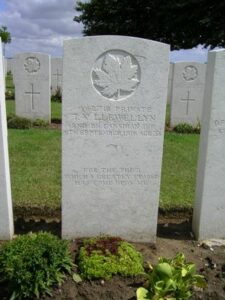
William Lloyd. William cannot presently be identified.
William Rees Reynolds, Second Lieutenant, Australian Infantry. William was the only son of Captain William Rees Reynolds, and Mary Reynolds, of Cilwenan Hill, Dinas Cross, Pembrokeshire, and of ‘The Astor’, Macquarie Street, Sydney, Australia. William was educated at Llandovery from 1909 until 1910, and was also educated at the Church of England Grammar School, North Sydney, Australia. William’s intention was to be a farmer, and on completion of his schooling, he enrolled for a course of Instruction at Wagga Experimental Farm. However, with the advent of War, instead of chasing his dream, William enlisted in the Australian Imperial Force on 18 June 1915, joining the Australian Army Medical Corps at Sydney. William was later posted to England, and became an Instructor, serving on Salisbury Plain. However, William wanted action, and so transferred into the Infantry, and was soon commissioned as Second Lieutenant into the 33rd Battalion, AIF, which was part of the 3rd Australian Division. The Battalion had to wait until the emphasis of British and Dominion operations switched to the Ypres Sector of Belgium in mid-1917 to take part in its first major battle; which was the battle of Messines, launched on 7 June. The battalion held the ground captured during the battle for several days afterwards and was subjected to intense artillery bombardment. One soldier wrote that holding the line at Messines was far worse than taking it. The battalion’s next major battle was around Passchendaele on 12 October. The battlefield, though, had been deluged with rain, and thick mud tugged at the advancing troops and fouled their weapons. The battle ended in a disastrous defeat. The 33rd Australian Battalion was called up to attack Crest Farm, where a previously captured pill-box had been re-taken by the enemy. It was in this attack that William was killed, along with five of his brother officers of the Battalion. He was 24 years old, and has no known grave, and so is commemorated on the Ypres (Menin Gate) Memorial, Belgium.
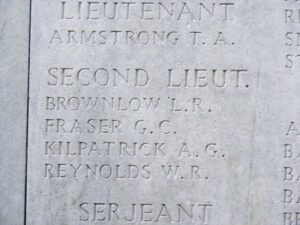
John Edward Richards, Mess Room Steward, Mercantile Marine. John was the son of Thomas and Isabella Richards (nee Williams), of Gate, Dinas Cross. He served in the Mercantile Marine as Mess Room Steward aboard the SS Woolston, a London registered Merchant ship. John was drowned when Woolston was sunk by a German submarine off Syracuse on 14 May 1918. He was 19 years old and is commemorated on the Tower Hill Memorial, London.
David John Roach, Private, 4443, Royal Fusiliers. David was the son of John and Elizabeth Roach, of 50, Monk Street, Aberdare. His mother Elizabeth died by around 1900, and in 1901 his father married Ann Williams, before moving the family to Dinas. By the time of the outbreak of war, David was living in London, where he enlisted into the 23rd Battalion, Royal Fusiliers. The Battalion was known as the Sportsmen’s Battalion, due to the high number of athletes and footballers in its ranks, and was attached to 99 Brigade, 2nd Division. One of the first Divisions to move to France, the 2nd Division remained on the Western Front throughout the war. They moved to Belgium, where they fought at the Battle of Mons, and retreating southwards, fought at the Affair of Landrecies, the Rearguard Actions of Villers-Cotterets, and at the Battle of the Marne where the German offensive was stopped. The Germans retreated north, and the BEF met them, fighting at the Battle of the Aisne. The 2nd Division were then moved to Flanders, where they fought at the First Battle of Ypres, when the German sweep through Flanders was stopped, and remained there throughout the first winter of the war. In 1915 they took part in the Battle of Festubert, and in September fought at the Battle of Loos, and subsequent Action of Hohenzollern Redoubt. David joined the battalion in France as a reinforcement early in 1916. In the summer of 1916 the Division were on the Somme, and took part in the Battle of Delville Wood. David was killed in action here on 27 July 1916. He was 19 years old, and was buried at Dive Copse British Cemetery, Sailly-le-Sec. His elder brother Tom also fell. Both brothers are also commemorated on plaques within the Church.
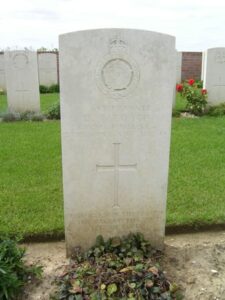
Tom Davies Roach, Company Serjeant Major, 201270, Tank Corps. Tom was the son of John and Elizabeth Roach, of 50, Monk Street, Aberdare. His mother Elizabeth had died by around 1900, and in 1901 his father married Ann Williams, before moving the family to Dinas. Tom enlisted into the Army, and was posted to the Tank Corps, where he rapidly rose to the rank of Company Serjeant Major. Tom served with the 7th Battalion, Tank Corps, and would have fought at the Battle of Cambrai, and during the 100 days offensive, which ultimately led to the winning of the war. He contracted influenza within the last days of the war and sadly succumbed to pneumonia and died on 29 November 1918 aged 27. He is buried at St. Pol British Cemetery, St. Pol-Sur-Ternoise, France. His next of kin is listed as being his sister, Mrs Maggie M. Bowen Evans, of Ty Hen, Dinas Cross. His brother David also fell. Both brothers are also commemorated on plaques within the Church.
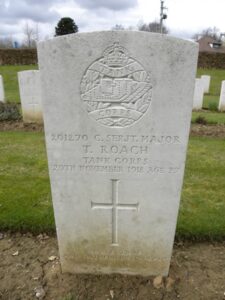
Edwin Thomas, Private, 302289, Manchester Regiment. Edwin was born in 1893, the son of Thomas and Dinah Thomas, of Glyn View, Dinas. He enlisted at Cardiff into the Army, and joined the 2/8th Battalion, Manchester Regiment, which was attached to 199 Brigade, 66th (2nd East Lancs) Division. The Division was a Territorial Division, and was on home service for the majority of the war. It concentrated on the Western Front by 16 March 1917 and moved to the Flanders Coast. At the end of September 1917 they moved to Ypres, and took part in the Battle of Poelcapelle. Edwin was killed in action at Poelcapelle on 8 October 1917. He was 24 years old, and is commemorated on the Tyne Cot Memorial, Belgium. His brother Morgan also fell.
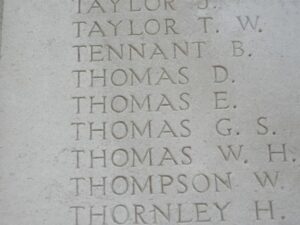
Morgan Lewis Thomas, Private, 46380, Welsh Regiment. Morgan was born in 1898, the son of Thomas and Dinah Thomas, of Glyn View, Dinas. He enlisted at Fishguard into the Army, and was posted to the 9th Battalion, Welsh Regiment, which was attached to 58 Brigade, 19th (Western) Division. The Division had fought at Loos in September 1915, and suffered heavy casualties on the Somme the following year. Morgan joined the 9th Welsh in France in the summer of 1916, and fought with them at Messines in the spring of 1917. The Division then fought on the Menin Road and at Polygon Wood, before moving up to Broodseinde, Poelcappelle and Passchendaele Village itself. In 1918 they were caught up in the German Spring Offensive near St. Quentin, where they suffered terrible casualties, and fought at the Battle of Bapaume. They moved to Ypres, but were caught up in the German attack at Messines, and at Bailleul, and Kemmel. Morgan was taken prisoner by the Germans during the early part of 1918, and brought to a Prisoner of War Camp in Germany. He died of wounds in Germany on 21 May 1918 aged 19, and is buried in Cologne Southern Cemetery, Germany. His brother Edwin also fell.
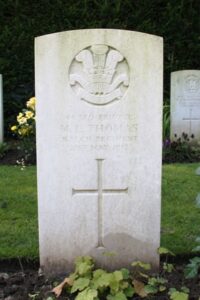
Titus James Thomas, Second Mate, Mercantile Marine. Titus was born in 1898, the son of Margaret Thomas, of Park Gwyn, Dinas Cross. He served in the Mercantile Marine as Second Mate aboard the SS Bayreaulx, a London registered Merchant Vessel of 3,009 tons. Bayreaulx sailed from Cardiff in ballast for Montreal on 20 October 1916 and was never seen again. The ship was officially registered as missing/untraced on 14 February 1917. It is believed she had hit a mine and sank with all hands not long after leaving Cardiff. Titus was one of the missing crewmen aboard her. He is recorded as having died on 20 October 1916, aged 26, and is commemorated on the Tower Hill Memorial, London.
World War Two, 1939-1945
John Kerswell Battin, Able Seaman, Merchant Navy. John was born in Abertridwr on 13 May 1908, the son of John and Elizabeth Battin (nee Kerswell). His mother died following his birth and his father brought the family back to Dinas. When he grew up, John moved to Barry to work as a labourer and married Elizabeth May Lane, of Cadoxton, Barry in 1934. The couple had a daughter, Winifred, born in 1935 and lived at 17, Chesterfield Street, Barry. John enlisted into the Merchant Navy at the outbreak of war and served as an Able Seaman aboard the Glasgow registered SS Lissa. On 21 September 1941 Lissa was en-route from Barry for Lisbon, carrying a cargo of coal, when she was torpedoed and sunk by the German submarine U-201. John was 33 years old when he died with the sinking of his ship, and is commemorated on the Tower Hill Memorial, London. His widow, Elizabeth, died in 1977 after having never remarried.
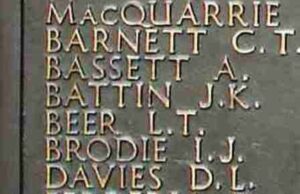
William James Bowen, Civilian. William was the son of William (Billy) and Elizabeth Bowen of Parc-y-Dinas, a smallholding on Dinas Mountain. He had emigrated to Australia prior to the war. William worked as a labourer in Darwin, on the north coast of Australia. He lived at a labourers tented camp called Frog Hollow Labourer Camp. At 10.00 on the morning of 19 February 1942, a force of around 188 Japanese fighter planes and dive-bombers launched from four aircraft carriers in the Timor Sea, led by Commander Mitsuo Fuchida, the man who had led the attack on Pearl Harbour just two months previously, attacked Darwin, causing much damage. A second wave of ground based bombers then hit the stricken port again at mid-day, concentrating their efforts on the nearby air base at RAAF Darwin. The combined attacks that day cost about seven ships sunk and many more damaged, and cost the lives of many innocent casualties, estimated to be between 250 to 300 from various sources. William was among a group of labourers killed whilst working on the docks that morning. He was 36 years old and is buried in Adelaide River Wartime Civilian Cemetery, Australia. (Thanks to Rex Harries for identifying William).
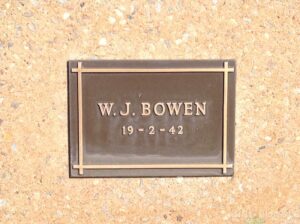
Harry William Clack, Aircraftman 1st Class, 575235, Royal Air Force. Harry was born on 11 November 1923, the son of Harry and Winifred Clack (nee Blake), of South Norwood, Surrey. Harry’s father enlisted into the Royal Air Force on 28 January 1918 and had probably been stationed at Trecwn after the war, but had died in 1935, aged just 35. His mother Winifred was the daughter of a Great War veteran. It’s likely that Harry’s family was evacuated from London to Cwmyregwys and stayed in the area throughout the war. Harry followed in his father’s footsteps and enlisted into the Royal Air Force at the outbreak of war, and was posted to 45 Maintenance Unit at RAF Henlow after receiving his basic training at RAF Halton. Harry’s unit was tasked with the recovery of crashed aeroplanes during the Battle of Britain, and on 25 October 1940, Harry and his team were sent to Eaton Socon, Bedfordshire to salvage a German Dornier 215, which has been shot down by RAF fighters. While attempting to recover the plane with a crane, the jib arm hit overhead power lines, killing Harry and another of his team, Harold Hooker. Harry was just 16 years old when he was killed that day, making him the youngest RAF crewman to be killed during the Battle of Britain. He is buried at Cambridge City Cemetery, England. Many thanks to Richard Huws for identifying Harry.
David Propert Harries, First Officer, Canadian Merchant Navy. David was the son of Mary Lizzie Harries, of Bwlchygroes, Dinas Cross. He joined the Merchant Navy as a young man and graduated at Cardigan on 6 December 1923, giving him the qualifications to serve as Second Mate on foreign-going steamships. By the time of the outbreak of the war, he was serving in the Canadian Merchant Navy, as First Officer, aboard the MV Victolite. At 03.28 hours on 11 February 1942, the unescorted Victolite was torpedoed by U-564 and sunk by gunfire north-northwest of Bermuda. The master, 44 crew members and two gunners were lost, although they had reportedly taken to the ships lifeboats. David was 39 years old when he was killed that day. He is commemorated on the Halifax Memorial, Canada.
Thomas Gwyn Harries, Private, 14342641, The Middlesex Regt (Duke of Cambridge’s Own). Thomas was the son of Owen and Margaret Harries, of Greenland, Brynberian. He married Elizabeth Mary Howells in 1933 and the couple lived in Bronrhiw, West Street, Newport. His sister, Maud, lived in Dinas. Thomas served with the 1/7th Battalion, Middlesex Regiment, which formed part of the 51st Highland Division. The division landed in Normandy on 7 June 1944, and took part in the break out from the beach-head, and the subsequent drive through France and Belgium into Holland, before crossing into Germany in 1945. Thomas was killed in Germany on 12 April 1945. He was 32 years old, and is buried at Reichswald Forest War Cemetery, Germany.
Thomas James Harries, Marine, PLY/X 101137, Royal Marines. Thomas was born on 15 July 1914, the son of Theophilus and Maggie Harries (nee Evans), of Fagwyr Einon, Dinas Cross. He married Gladys Mary Thomas in 1936 and the couple lived in Cilau Lodge, Scleddau, near Fishguard, where Thomas worked as an Admiralty Chain-man, and the couple had a son, Glyn. Thomas enlisted into the Royal Marines and was sent to North Africa with the 11th Battalion, Royal Marines in 1941. On 13 September 1942, Tom was part of a force of some 380 Royal Marines embarked on the destroyers HMS Sikh and HMS Zulu from Alexandria to take part in a night raid on the port of Tobruk. The ships were bombarded by shore based heavy guns and many of the small boats were sunk and the marines either killed or drowned. Fewer than 100 men reached the shore and those that survived the heavy fighting surrendered to a party of German soldiers. Sadly, nothing is known of the exact circumstances of Thomas’ death, but he was among those killed on 14 September 1942. He was 28 years old and is commemorated on the Plymouth Naval Memorial, Devon.
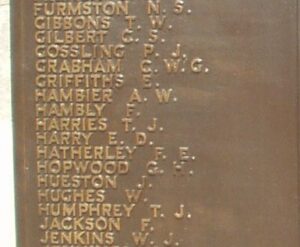
William Richards Harries, Master, Merchant Navy. William was the son of Elizabeth Harries, of 3, The Cross, Dinas. He had enlisted into the Merchant Navy as a young man and qualified as First Mate of a foreign-going steamship at Swansea on 26 October 1922. He was in Montreal, Canada prior to the outbreak of war and returned to Britain aboard the White Star liner Alaunia on 30 May 1939. He was then given the position of Master of the London registered SS Norman Prince, a new ship which was completed in April 1940. At just after 01.11 on the morning of 29 May 1942 Norman Prince was steaming unescorted when she was struck on the starboard side by a torpedo fired from the German submarine U-156, some 70 miles west of Martinique. The ship ground to a halt, her engine room flooded, and chaos ensued. A DEMS gunner tried to launch a lifeboat and nearly sank it, before one of the ships officers sorted out the situation, then the officer and ten crew boarded the vessel. The remaining crew attempted to launch the other lifeboats, but another torpedo struck the doomed Norman Prince and it sank quickly, with the loss of her master, William Harries, 13 crew members and two DEMS gunners. Some of the survivors were picked up by a French steamer and were interned. One survivor relayed the tale that he had got off the ship, together with William and some other men, but was the only one to survive from their group. William was 42 years old when he drowned following the sinking of Norman Prince on 28 May 1942. He is commemorated on the Tower Hill Memorial, London. He is also commemorated on the Halifax Memorial, Nova Scotia.
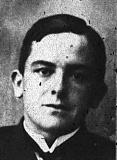
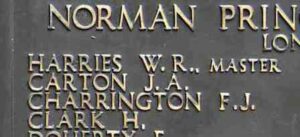
William Norton James, Sergeant, 1338403, Royal Air Force Volunteer Reserve. William was the son of William and Florence James, of 1, Poplars, Dinas. He served with the Royal Air Force Volunteer Reserve, as a Wireless Operator/ Air Gunner, with 61 Squadron. The Squadron was part of No. 5 Group, Bomber Command, equipped with the Lancaster heavy bomber, based at Rutland. On the night of 30 March 1944 William took off from Rutland aboard Lancaster R5734, which was part of a large ‘thousand-bomber raid’ on Nuremberg. His aircraft completed its mission, but during its return flight on the following morning was intercepted by a German pilot, Major Rudolf Schoenert in his Junkers 88, who shot the Lancaster down near Monin, some 25km south-east of Namur in Belgium. A total of 108 aircraft were lost during the raid. Norton was 20 years old when he was killed on 31 March 1944, and is buried in Heverlee War Cemetery, Belgium.
Daniel John Jenkins, Able Seaman, Merchant Navy. Daniel, known by his nick-name Jackie, was the son of John and Annie Jenkins, of 1, Glendower, Dinas Cross. He was one of the four Dinas men who served with the Merchant Navy aboard the SS Empire Amethyst, a Middlesbrough registered steam tanker, of 8,023 tons. On 13 April 1942, when on route from New Orleans for Freetown, carrying a load of 12,000 tons of motor spirit, she was torpedoed by U-1564 and exploded, going down with all hands. Daniel was 25 years old, and is commemorated on the Tower Hill Memorial, London.
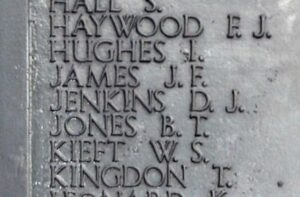
Alun Jones, Private, 14659174, The Welch Regiment. Alun was the son of William Harries Jones and Mary Ann Jones, of Capel Newydd, near Dinas Cross. He served in the Army with the 4th Battalion, Welch Regiment, which was the Carmarthenshire Territorial unit. After serving in Northern Ireland for some of the war, the Division returned to England for training, and landed at Normandy at the end of June 1944. From here it was part of the Allied forces that broke out of the Normandy beachhead the following month, beginning a long advance through northern France into Belgium and Holland. After months of heavy fighting, the Division had fought its way through Holland, and had entered the mighty Reichswald Forest, inside Germany, and began the push towards Hamburg. On 7 March 1945 the 4th Welch were involved in heavy fighting around the town of Spitzfeld, and it was here that Alun was killed in action. He was just 19 years old, and is buried at Reichswald Forest War Cemetery, Germany.
Benjamin Thomas Jones, Cook, Merchant Navy. Benjamin was born on 20 July 1918, the son of Elias and Phoebe Anne Jones, of Star House, Bwlchmawr, Dinas. He was one of the four Dinas men who served aboard the SS Empire Amethyst, a Middlesbrough registered oil tanker. On 13 April 1942, when on route from New Orleans for Freetown, carrying a cargo of 12,000 tons of clean oil she was torpedoed by U-1564 and exploded, sinking with the loss of all her crew. Benjamin was 23 years old, and is commemorated on the Tower Hill Memorial, London.
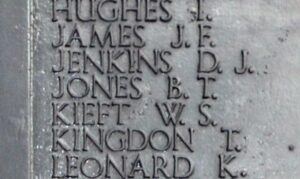
William Adrian Lewis, Sailor, Merchant Navy. William was born in 1926, the son of David Thomas Lewis and Margaret Lewis (nee Price), of 4, Cambrian Terrace, Feidr Fawr. His father was a teacher in Dinas School. William went to sea as a young man, joining the Merchant Navy when he was about 16 and probably saw service at sea towards the end of the war. Some years afterwards he was serving aboard the BP oil tanker British Scout. On Saturday 12 April 1952, William had left his ship and taken a train from Bristol Temple Meads Station to Cardiff. He died during an accident near Newport that same day, aged 24. His body was brought home to Dinas, and William was buried at St. Brynach Churchyard, Dinas Cross on 18 April 1952. He is obviously not commemorated by the CWGC as he was not a casualty of war, and died seven years after the end of hostilities.
Elwyn Lloyd, Ordinary Seaman, Merchant Navy. Elwyn was the son of William and Beatrice Lloyd, of Cwm Dewi Bach, Pwllgwaelod. He was another of the four Dinas men serving aboard the oil tanker SS Empire Amethyst. Elwyn was among the crewmen killed on 13 April 1942 when on route from New Orleans for Freetown, carrying a cargo of 12,000 tons of clean oil she was torpedoed by U-1564 and sunk. He was just 19 years old, and is commemorated on the Tower Hill Memorial, London.
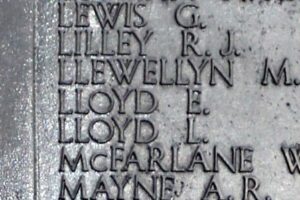
David John Morris, DSC, Lieutenant, Royal Naval Reserve. David was the son of Thomas and Margaret Ann Morris, of Penymynydd and Rock House, Dinas. He married Nancy Olwen Roach, of Fishguard, at Swansea in 1942. He was an experienced mariner and upon the outbreak of war volunteered to serve with the Royal Naval Reserve. He was given command of the minesweeper HMS Saronta in 1942 and for his work on minesweeping duties in the Mediterranean, was awarded the Distinguished Service Cross, which was listed in the London Gazette of 5 October 1943. On 17 August 1944 David was appointed as an Admiralty Pilot at HMS Baldur, the shore based Royal Navy Headquarters in Reykjavik. On 10 November 1944, news reached the Icelandic Command that convoy UR-142 was being attacked by a U-boat as it approached Iceland from Loch Ewe in Scotland in storm-force conditions. A rescue attempt was organised from HMS Baldur, and the David set out aboard the tug Empire Wold to attempt a rescue. The tug never reached the convoy, sinking in the heavy seas with the loss of her Master, Henry Draper, seven Royal Navy personnel, including David, and eight Merchant Navy crew. The tug was discovered intact in May 2018, 74 years after its loss. David was 38 years old when he was lost with the tug Empire Wold on 10 November 1944. He is commemorated on the Chatham Naval Memorial, Kent. He is one of the three Morris brothers of Dinas who died at sea during the war.
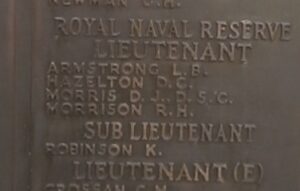
Ivor James Morris, Able Seaman, Merchant Navy. Ivor was the son of Thomas and Ann Morris, of Penymynydd and Rock House, Dinas. He was another of the four Dinas men serving aboard the oil tanker SS Empire Amethyst. Ivor was among the crewmen killed on 13 April 1942 when on route from New Orleans for Freetown, carrying a cargo of 12,000 tons of clean oil she was torpedoed by U-1564 and exploded, sinking with the loss of all hands. He was 25 years old, and is commemorated on the Tower Hill Memorial, London. He is one of the three Morris brothers of Dinas who died at sea during the war.
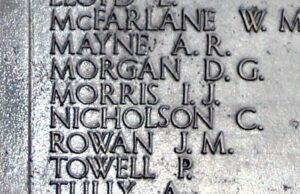
William Paul Morris, Quartermaster, Merchant Navy. William was the son of Thomas and Ann Morris, of Penymynydd and Rock House, Dinas. He married Anne Bowen of Penbanc, Newport, in 1938. He served with the Merchant Navy, like his brothers, and had taken part in the Russian Convoys early in the war. By 1943 he was serving as Quartermaster aboard the Liverpool registered SS City of Guildford. On 27 March 1943, City of Guildford was en-route from Alexandria to Tripoli with Convoy XT-7, when she was struck by a spread of torpedoes which had been fired by the German submarine U-593, and sank with the loss of 70 crew members, 11 DEMS gunners and 48 army personnel. William was 31 years old when he died that day and is commemorated on the Tower Hill Memorial, London. He is one of the three Morris brothers of Dinas who died at sea during the war.
David Bramwell Murrow, Ordinary Seaman, D/JX 219840, Royal Navy. David was born in Blaengarw on 4 December 1913, the son of Mary Lizzie Murrow. Mary was from Garnwen, Dinas, but had moved away to Blaengarw to work, so David actually never lived in Dinas. In 1920, Mary Lizzie, then aged 39, married James Bowen and the couple set up home at 110A Llwydarth Road, Maesteg. David joined the Merchant Navy prior to 1925 and is shown as returning from Calcutta in 1925, along with a friend George Davies, of Penpark, Cardigan. By 1939 David had moved back in with his mother and was working as a general labourer. At the outbreak of war, he enlisted into the Royal Navy and was posted aboard the training ship Medoc. On the afternoon of 26 November 1940, Medoc was loaded with a cargo of ammunition, and had set off from Plymouth toward the Eddystone Lighthouse. At about 18.00, halfway between Plymouth Sound and the Eddystone Lighthouse, one of the lookouts saw a twin-engine aircraft approaching on the port side. The German pilot opened fire with his machine guns, circled again and dropped a torpedo into the water, which struck the boiler room on the port side. The men threw rafts overboard and launched the lifeboats just before the ships bow went down. Depth charges on board the sinking ship exploded causing casualties amongst the survivors floating in the water. Thirty-nine lives were lost aboard Medoc, including David Murrow. He was 27 years old, and is commemorated on the Plymouth Naval Memorial, Devon.
Huw Jeffrey Owen, Second Officer, Merchant Navy. Huw was the son of Robert Jeffrey and Annie Owen of Whitchurch Cardiff. He married Margaret Georgina Williams, the daughter of David and Lizzie Williams, of Cilwenen, Dinas in 1939. Huw served with the Merchant Navy aboard the Swansea registered steamship SS Henri Mory. On 26 April 1941 Henri Mory was some 330 miles west of Ireland, en-route from Bermuda to Barrow in Furness, when at about 13.30 it was hit on the starboard side of the engine room by a torpedo which had been fired from the German submarine U-110. Henri Mory sank in less than four minutes due to the weight of the manganese ore in her hold. Out of a crew of 32 only four men managed to escape the suction of the sinking ship to reach a lifeboat. Huw was 24 years old when he died that day and is commemorated on the Tower Hill Memorial, London.
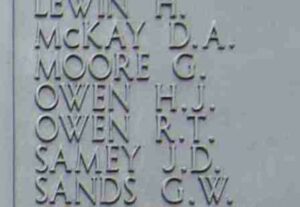
Thomas James Walters, Able Seaman, Merchant Navy. Thomas was the son of James and Martha Walters of 3 Garden Terrace, Bwlchmawr, Dinas. In 1918, Thomas James married his next door neighbour, Martha Lizzie Morris and they made their home in nearby Aeron, Bwlchmawr. Thomas was a long serving Merchant Mariner and early in the war was serving aboard the Southampton registered MV Gatinais. On 3 December 1942, Gatinais carrying a cargo of scrap iron from Portsmouth to Llanelli when she joined Convoy PW257. The convoy was spotted by the German 5th S-Boat flotilla some five miles off Start Point. The Germans were working in conjunction with a Wolf Pack of German U-Boats and the combined force attacked the convoy. Gatinais was hit by a torpedo fired from one of the U-Boats and sank with the loss of nine lives. Thomas, at 57 years old, was the oldest WW2 casualty from Dinas. He is commemorated on the Tower Hill Memorial, London.
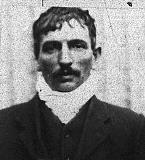
Dewi Thomas Williams, Sick Berth Attendant, D/MX 64881, Royal Navy. Dewi was born on 21 September 1919, the son of David Henry Williams and Bessie Williams (nee Roach), of Anchor Villa, Feidr Fawr, Dinas. He worked as a bank clerk in Bristol prior to the war then enlisted into the Royal Navy. He was based at HMS Drake, the Royal Naval Base at Plymouth. Dewi was one of three sailors killed during an air raid on Plymouth on 22 April 1941, when a German bomb struck the barracks where they were living. He was 21 years old and is buried at Plymouth (Weston Mill) Cemetery.
Gwynne Williams, Sapper, 14885333, Royal Engineers. Gwynne son of John and Nellie Williams of Bryngelly, Bwlchmawr, Dinas. He served during the end of the war with the Royal Engineers. He was wounded in Germany when his convoy was attacked by German fighter planes. He came back to Britain via a chain of field hospitals and was treated at Derby. He remained in the army after the war, based at Burton on Trent with No. 1 Railway Home Group Royal Engineers. Gwyn was badly injured when he was struck by an army lorry whilst attending to an issue with his own lorry and died at Burton on Trent Infirmary on 3 November 1947, aged 23. His body was brought home to Dinas and he was buried with full military honours in Macpelah Baptist Cemetery, Dinas.
